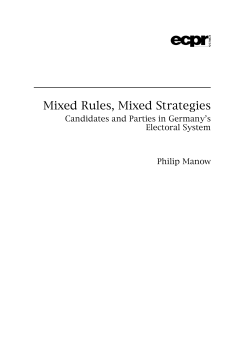
Additional Information
Book Details
Abstract
Sixty years of democratic representation in Germany allow us to study the working of a specific type of electoral system, namely a mixed system combining proportional and majoritarian rules, in great detail.
Mixed systems have figured as a reference point in many reform debates of the recent past. This is because they appear to combine advantageous traits of proportional and majoritarian rules, such as fairness, proximity between constituencies and representatives, and stable government majorities. Mixed systems have also attracted much scholarly attention of late, because they allow us to study the effects of electoral rules while holding many intervening variables constant. But they also attract interest because the proportional and majoritarian electoral tiers affect each other in ways that differ from what would have resulted under pure PR or plurality.
All this makes mixed systems a fascinating object of study, and the German system is its oldest and prototypical exemplar.
'Professor Manow’s book establishes a new standard for work on German elections and on mixed-member proportional electoral systems more generally. Given the influence of the German system on electoral system designers around the world in the past quarter century, this book should rightly find a broad audience.'
John M Carey, Dartmouth College
'Professor Manow provides a terrific summary of the modern literature on Germany’s mixed electoral system and extends it in several directions. Highly recommended for scholars of mixed electoral systems.'
Jens Hainmueller, Stanford University
Table of Contents
| Section Title | Page | Action | Price |
|---|---|---|---|
| Mixed Rules, Mixed Strategies | i | ||
| Contents | v | ||
| List of Figures and Tables | vii | ||
| List of Abbreviations | xv | ||
| Acknowledgements | xvii | ||
| Preface | xix | ||
| Chapter One Introduction | 1 | ||
| PART I PARTIES IN GERMANY’S MIXED-ELECTORAL SYSTEM | 19 | ||
| Chapter Two The Contaminated Cube Rule | 21 | ||
| Chapter Three Of the Cannibalistic Consequences | 43 | ||
| Chapter Four Contesting Districts: Why small parties enter (hopeless) district races | 61 | ||
| Chapter Five Coordinating: Locally or nationally? Or what if German parties suddenly behaved in a Duvergerian fashion? | 87 | ||
| PART II CANDIDATES IN GERMANY’S MIXED ELECTORAL SYSTEM | 105 | ||
| Chapter Six Candidatures: Turning candidates into MPs | 107 | ||
| Chapter Seven Combining Candidatures: Hedging against electoral uncertainty | 127 | ||
| PART III MPS IN GERMANY’S MIXED ELECTORAL SYSTEM | 143 | ||
| Chapter Eight Careers: Electoral rules and legislative turnover | 145 | ||
| Chapter Nine Characteristics: Electoral pathways to the Bundestag and MPs’ parliamentary strategies | 159 | ||
| Chapter Ten Conclusion | 181 | ||
| Appendix to Chapter Two | 189 | ||
| Index | 209 |
